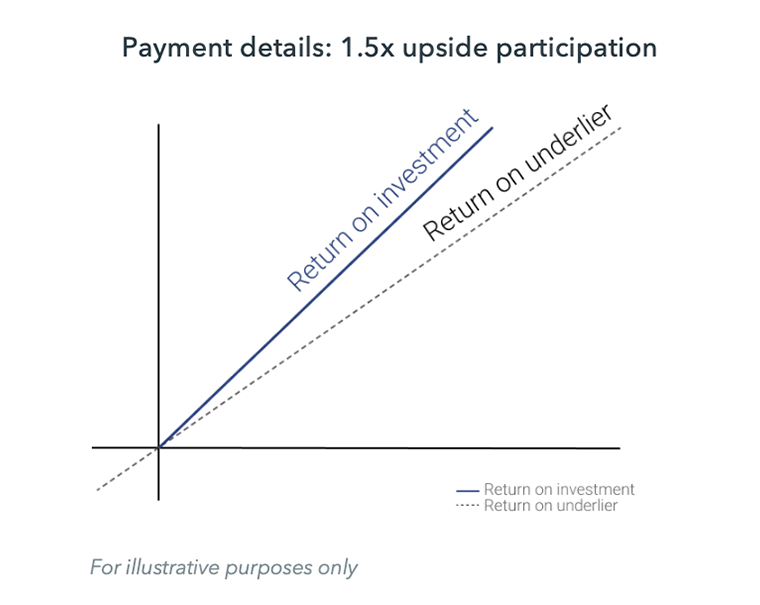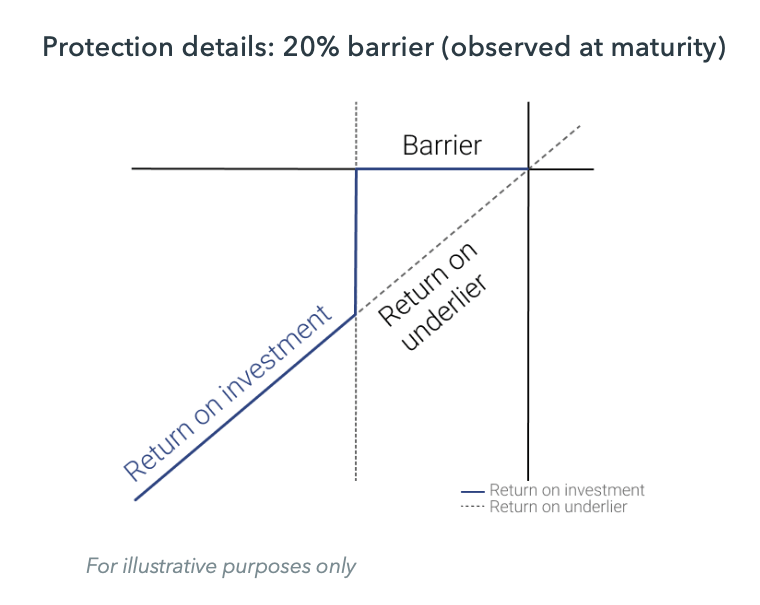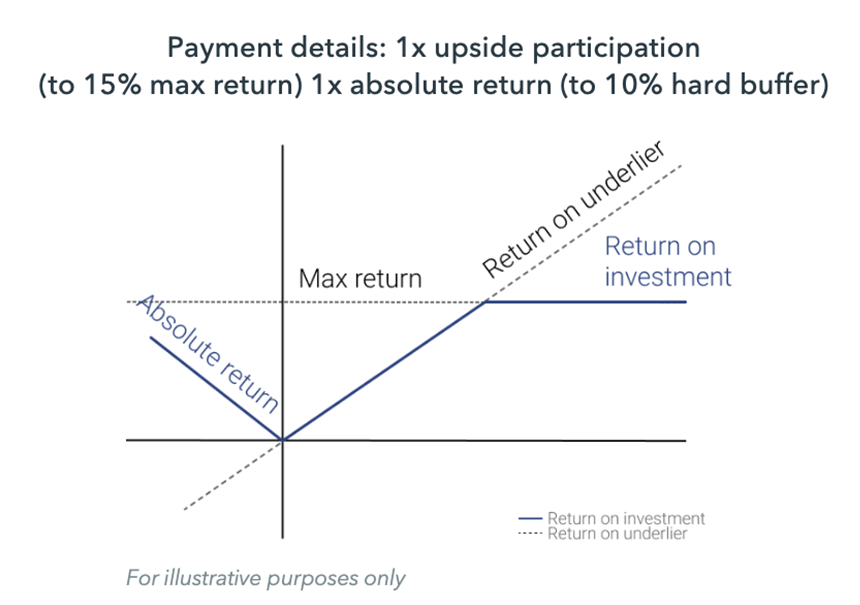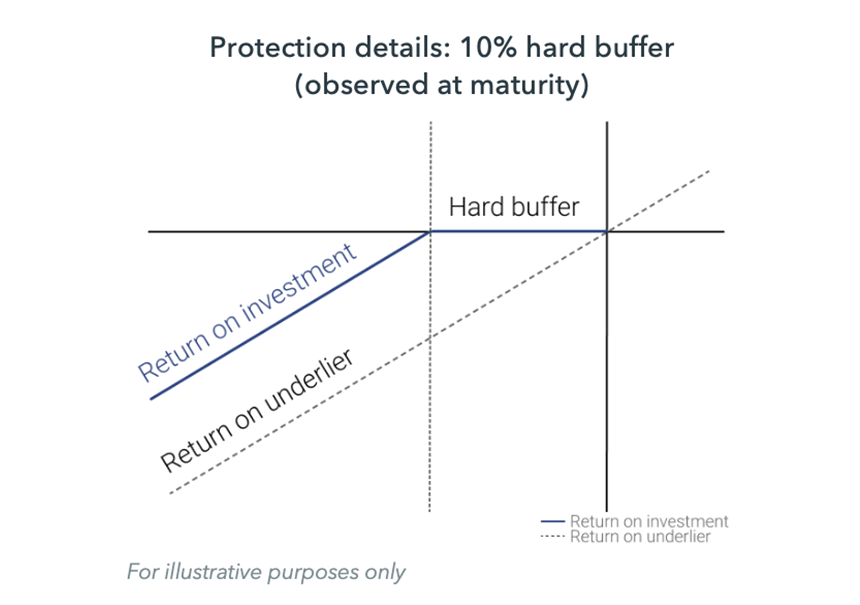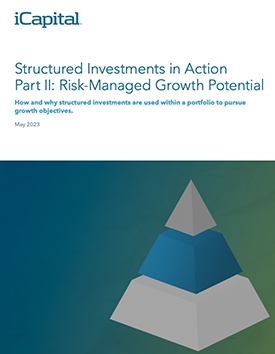How and Why Structured Investments are Used Within a Portfolio to Pursue Growth Objectives
Growth-oriented structured investments are typically used to achieve consistent market exposure, with embedded protective features that can provide a degree of risk management in a portfolio. Other times, and still on the growth side of the portfolio, structured investments can be used to try to capitalize on a specific market outlook (bullish or bearish) or to gain efficient, risk-tailored exposure to strategies that may be difficult to access directly.
Growth investors considering any structured investment should do the following:
- View structured investments as buy-and-hold strategies whose payouts are not promised until maturity.
- Understand there is no guaranteed secondary market and that while issuers have historically bought back structured investments, they are under no legal obligation to do so.
- Be comfortable with the issuer’s creditworthiness since payments made by structured investments are subject to the credit risk of the issuer.
What do growth-oriented solutions look like in the structured investment world? A high-level overview can shed some light:
Growth solutions:
- Enable investors to participate in the potential growth of a desired market, often with some risk mitigation.
- Are generally characterized by a single payment at maturity.
- Are tied to the return of an underlier, such as an equity index, a basket of indices or a stock.
- Can offer full principal protection, partial protection, or no protection at all.
Highlighted below are a few hypothetical scenarios to show structured investments can be used to achieve growth objectives.
Growth Use Case #1: International Exposure, With a Degree of Protection
The objective: An investor seeks the potential growth and diversification that may come with international equity exposure. She is optimistic about emerging markets specifically, and comfortable with equity risk. However, she would appreciate some downside protection should those markets experience a slight to moderate decline.
A potential solution: A market linked growth note with upside participation tied to a broad emerging market equity index, along with barrier protection.
This type of note can be visualized in the below hypothetical illustration:
Underlier: MSCI Emerging Markets Index
Term: 4 years
At maturity, the barrier would absorb the first 20% of any losses in the index but after that, protection would disappear, and losses would be one-to-one from the index’s initial level.
In other words, if the index is at 80% or above of its initial level at maturity, an investor would receive his or her full principal back. However, if the index is below 80% of its initial level at maturity, an investor would take losses from the index’s initial level.
Benefits:
- Leveraged and uncapped participation in any gains in the underlier at maturity.
- Return of principal, so long as the underlier has not declined below the barrier at maturity.
Considerations:
- Leveraged and uncapped participation in any gains in the underlier at maturity.
- Return of principal, so long as the underlier has not declined below the barrier at maturity.
Example #2: Expressing an Investment View
The objective: An investor follows the market closely and feels that over the coming 18 months U.S. equity returns may be more muted, or even slightly negative (he expects single-digit returns, either positive or negative). He wants to remain engaged in the markets, but also somewhat protected if market gains do not continue.
A potential solution: A market linked growth note that offers exposure to U.S. equities with the potential for a return regardless of whether market performance is positive or negative, and a degree protection against a market decline.
Underlier: S&P 500 Index
Term: 18 months
At maturity if the underlier has increased, an investor would participate in any gains in the underlier up to a pre-determined maximum return of 15%.
If the underlier has declined but is at or above 90% of its initial level, an investor would receive an absolute return payment in the amount of the decline.
At maturity, the barrier would absorb the first 20% of any losses in the index but after that, protection would disappear, and losses would be one-to-one from the index’s initial level.
In other words, if the index is at 80% or above of its initial level at maturity, an investor would receive his or her full principal back. However, if the index is below 80% of its initial level at maturity, an investor would take losses from the index’s initial level.
Benefits:
- Upside participation (up to a cap) in any gains in the underlier.
- Payment even if the underlier return is negative, as long as negative return is not below the hard buffer level at maturity.
Considerations:
- The hard buffer only protects principal against a degree of decline in the underlier; losses could be significant.
- The underlier’s return is based on price return only and does not include dividends.
Informed Investing
Structured investments come in a wide variety with different terms and conditions. There’s one for almost any market outlook or investment goal, giving investors the chance to stay in the market and choose how much protection they need to feel comfortable.
When considering any structured investment, investors should understand the type of protection it offers, if any, as well as its payout potential, by carefully reviewing the offering documents before investing.
Securities products and services may be offered through iCapital Markets, LLC a registered broker/dealer, member FINRA and SIPC, and an affiliate of Institutional Capital Network, Inc. (“iCapital”). Please see the disclaimer at the end of this document for more information.
Please contact your financial professional or a fund manager to learn more.
IMPORTANT INFORMATION
The material herein has been provided to you for informational purposes only by Institutional Capital Network, Inc. (“iCapital Network”) or one of its affiliates (iCapital Network together with its affiliates, “iCapital”). This material is the property of iCapital and may not be shared without the written permission of iCapital. No part of this material may be reproduced in any form, or referred to in any other publication, without express written permission of iCapital.
This material is provided for informational purposes only and is not intended as, and may not be relied on in any manner as, legal, tax or investment advice, a recommendation, or as an offer or solicitation to buy or sell any security, financial product or instrument, or otherwise to participate in any particular trading strategy. This material does not intend to address the financial objectives, situation, or specific needs of any individual investor. You should consult y our personal accounting, tax and legal advisors to understand the implications of any investment specific to your personal financial situation.
STRUCTURED INVESTMENTS ARE CONSIDERED COMPLEX PRODUCTS AND MAY NOT BE SUITABLE FOR ALL INVESTORS. Please note that there is no public secondary market for structured investments. Although the issuer may from time to time make a market in certain structured investments, the issuer does not have any obligation to do so and market making may be discontinued at any time. Accordingly, an investor must be prepared to hold such investments until maturity. Any or all payments are subject to the creditworthiness of the issuer. Before investing in any product, an investor should review the prospectus or other offering documents, which contain important information, including the product’s investment objectives or goals, its strategies for achieving those goals, the principal risks of investing in the product, the product’s fees and expenses, and its past performance.
iCapital Markets LLC operates a platform that makes available financial products to financial professionals. In operating this platform, iCapital Markets LLC generally earns revenue based on the volume of transactions that take place in these products and would benefit by an increase in sales for these products.
The information contained herein is an opinion only, as of the date indicated, and should not be relied upon as the only important information available. Any prediction, projection or forecast on the economy, stock market, bond market or the economic trends of the markets is not necessarily indicative of the future or likely performance. The information contained herein is subject to change, incomplete, and may include information and/or data obtained from third party sources that iCapital believes, but does not guarantee, to be accurate. iCapital considers this third-party data reliable, but does not represent that it is accurate, complete and/or up to date, and it should not be relied on as such. iCapital makes no representation as to the accuracy or completeness of this material and accepts no liability for losses arising from the use of the material presented. No representation or warranty is made by iCapital as to the reasonableness or completeness of such forward-looking statements or to any other financial information contained herein.
Securities products and services are offered by iCapital Markets, an SEC-registered broker-dealer, member FINRA and SIPC, and an affiliate of iCapital, Inc. and Institutional Capital Network, Inc. These registrations and memberships in no way imply that the SEC, FINRA, or SIPC have endorsed any of the entities, products, or services discussed herein. Annuities and insurance services are provided by iCapital Annuities and Insurance Services LLC, an affiliate of iCapital, Inc. “iCapital” and “iCapital Network” are registered trademarks of Institutional Capital Network, Inc. Additional information is available upon request.
© 2024 Institutional Capital Network, Inc. All Rights Reserved. | 2024.01



